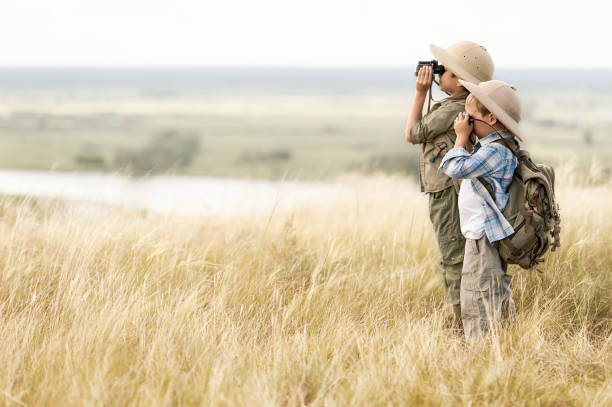
- Tanzania - East Africa
How Strenuous Are Walking Safaris?
Walking safaris are one of the most immersive ways to experience Africa’s wilderness. Unlike game drives, where travelers sit comfortably in a safari vehicle, a walking safari allows participants to step directly into the natural environment of lions, elephants, giraffes, zebras, and countless bird species. However, one of the most common questions travelers ask is: how strenuous are walking safaris?
The answer depends on several factors — the terrain, duration, altitude, weather, and fitness level of the traveler. While walking safaris are designed to be accessible for most people, the experience still involves some level of physical activity. This article explains how strenuous walking safaris really are, what to expect, how to prepare, and whether they are suitable for different travelers, from children to elderly adventurers.
What Are Walking Safaris?
A walking safari is a guided trek on foot through a national park, game reserve, or private conservancy, led by an experienced ranger and often accompanied by an armed wildlife scout. Instead of viewing animals through the window of a 4×4, participants experience the bush at ground level — hearing the rustle of grass, smelling the wild sage, and spotting animal tracks and signs.
This makes walking safaris a slow, sensory, and intimate experience rather than a physically demanding endurance challenge. The goal is not distance, but rather connection with the environment.
How Strenuous Are Walking Safaris Compared to Game Drives?
When comparing walking safaris to game drives, the difference in physical exertion is clear:
Game Drives: Almost no physical effort; participants sit in a safari vehicle for hours, covering long distances with minimal walking.
Walking Safaris: Moderate physical effort; participants walk between 3–10 kilometers per day, usually at a leisurely pace, stopping frequently to observe wildlife, plants, and landscapes.
So, how strenuous are walking safaris? They are more physically engaging than vehicle safaris, but they are not high-intensity treks. Most are designed for average fitness levels.
Factors That Determine Strenuousness of Walking Safaris
The level of exertion on a walking safari depends on multiple variables:
1. Terrain
Flat savannahs, like in Tarangire or Serengeti short walks, are easy and require minimal effort.
Hilly or rocky areas, such as parts of the Ngorongoro Highlands, are more strenuous.
Sandy riverbeds and uneven trails require additional energy.
2. Duration
Short walking safaris: 1–2 hours, suitable for almost all travelers.
Half-day safaris: 3–4 hours of walking with breaks.
Multi-day walking safaris: Covering longer distances, camping in the bush overnight. These can be more demanding and require better stamina.
3. Climate
Hot, humid weather increases difficulty.
Early morning and late afternoon walks are usually cooler and less strenuous.
4. Altitude
Parks like the Ngorongoro Highlands or Mount Meru foothills involve higher altitudes, which may make walking more strenuous.
5. Traveler’s Fitness
Most walking safaris are low to moderate intensity, suitable for anyone with average health.
Very young children or travelers with mobility limitations may find them more difficult.
Chat with our expert direct via email!
How Strenuous Are Walking Safaris in Tanzania?
Tanzania is one of the best destinations for walking safaris, offering experiences in the Serengeti, Tarangire, Ngorongoro, Ruaha, Selous (Nyerere National Park), and Arusha National Park. Each has its own level of challenge:
Serengeti Walking Safaris: Mostly flat, easy terrain. Short walks are not strenuous.
Ngorongoro Crater Rim Walks: More challenging, with steep areas and higher altitudes.
Arusha National Park Canoe + Walking Safari: Easy to moderate; terrain varies.
Selous (Nyerere) and Ruaha: Remote, with longer walks; more strenuous but still manageable.
So, how strenuous are walking safaris in Tanzania? Most are accessible to average travelers, but longer multi-day treks in Ruaha or the Crater Highlands can be moderately demanding.
Who Can Join a Walking Safari?
When asking “how strenuous are walking safaris,” the answer also depends on who you are:
Adults with average fitness: Can comfortably join most walking safaris.
Children: Some parks set age restrictions (usually 12–16 years minimum).
Elderly travelers: Short walks are usually fine, especially if done at a slow pace.
Adventurers & fit travelers: Can choose multi-day treks that are more physically challenging.
Safety and Strenuousness
A major concern is whether walking safaris are too strenuous to be safe. In fact, walking safaris are carefully designed for comfort and security:
Pace is slow, with frequent stops.
Rangers are experienced, ensuring participants never over-exert themselves.
Water breaks are frequent.
Distances are flexible, adjusted to participants’ ability.
So, even if you worry about “how strenuous are walking safaris,” rest assured — guides tailor the pace to your fitness.
Comparing Walking Safaris to Other Activities
To fully answer the question “how strenuous are walking safaris?”, it helps to compare them with other Tanzania activities:
Walking Safari vs. Kilimanjaro Trek: Kilimanjaro is far more strenuous, requiring days of uphill trekking at altitude. Walking safaris are leisurely in comparison.
Walking Safari vs. Cultural Village Tour: Similar in effort; both involve gentle walking.
Walking Safari vs. Hot Air Balloon Safari: Balloon safaris require almost no physical effort, while walking safaris require moderate exertion.
Thus, walking safaris sit in the middle of the spectrum — more active than game drives, less strenuous than mountain trekking.
Tips to Make Walking Safaris Less Strenuous
Travelers often ask not only “how strenuous are walking safaris?” but also how to make them easier. Here are tips:
Wear proper footwear: Comfortable, sturdy walking shoes.
Stay hydrated: Carry water.
Wear light clothing: To avoid overheating.
Pace yourself: Walk slowly, enjoy the scenery.
Choose short walks if you’re unsure of fitness.
Communicate with your guide about your comfort level.
Are Walking Safaris Suitable for Families?
Parents often wonder how strenuous are walking safaris for children. Generally, they are not too difficult, but age restrictions apply. Some lodges offer family-friendly short walks around camp or near safe areas.
Are Walking Safaris Suitable for Older Travelers?
For elderly travelers asking how strenuous are walking safaris, the answer depends on health and stamina. Short, easy walks are perfectly suitable, while long treks might be too much. Many operators customize safaris to suit seniors.
The Real Experience: More Mental than Physical
Interestingly, many travelers report that walking safaris are less physically strenuous than they feared, but more mentally intense. Being on foot near elephants, buffalo, or lions requires alertness and focus, which can be mentally taxing.
So, how strenuous are walking safaris? The physical challenge is mild to moderate, but the mental thrill is high.
FAQs About How Strenuous Walking Safaris Are
Q: Do I need to train for a walking safari?
A: No, basic fitness is enough.
Q: How far do you walk each day?
A: Between 3–10 km, depending on the safari.
Q: Are walking safaris safe for people with health conditions?
A: Yes, but inform your operator in advance.
Q: Do you carry heavy backpacks?
A: No, only essentials; porters carry equipment for multi-day safaris.
Q: Are walking safaris more tiring than game drives?
A: Yes, slightly more, but still manageable.
Final Answer: How Strenuous Are Walking Safaris?
So, how strenuous are walking safaris?
They are generally moderately active, designed for people with average fitness. Short walks are easy and suitable for most ages, while multi-day treks are more demanding. The pace is slow, with breaks, making the experience enjoyable rather than exhausting.
Walking safaris are not about testing endurance but about slowing down to connect with nature. If you can comfortably walk for a couple of hours at home, you will manage a walking safari in Tanzania or elsewhere in Africa.
In conclusion, walking safaris are not very strenuous — they are more about discovery, patience, and immersion than about physical challenge.
📌 Build Your Tour Today!


Olduvai Tours Tan_Africa
We ensure that your journey is not just a trip but a meaningful exploration of Tanzania’s natural and cultural treasures. Let us turn your dream safari into reality!
Booking your Adventure with Olduvai Tours Tan Africa
Olduvai Tours Tan Africa specializes in creating unforgettable Tanzania safari experiences, offering expert guides, personalized itineraries, and high-quality service.
Other Tours You May book with Olduvai Tours Tan_Africa:
Tanzania – East Africa Is It Possible to Do a Day Trip to a Park from Arusha? Arusha is…
Book 4 Days Tanzania Luxury Safari Itinerary Book Your 4 Days Luxury Safari Package! Tour Package Details 📍 Tarangire…
Affordable Group Joining Safari in Tanzania 2025 – Budget-Friendly 📍 Serengeti National Park, Ngorongoro Crater and Tarangire National Park…

